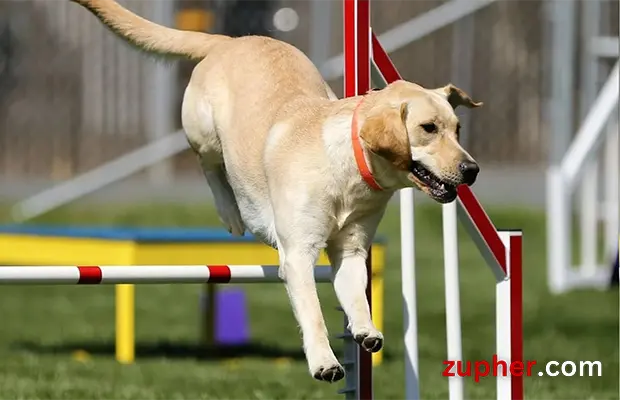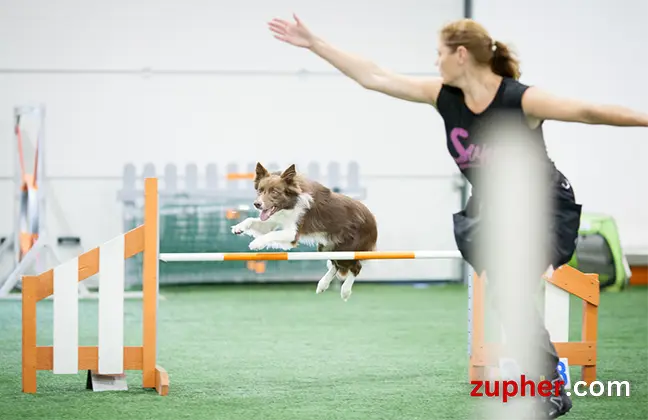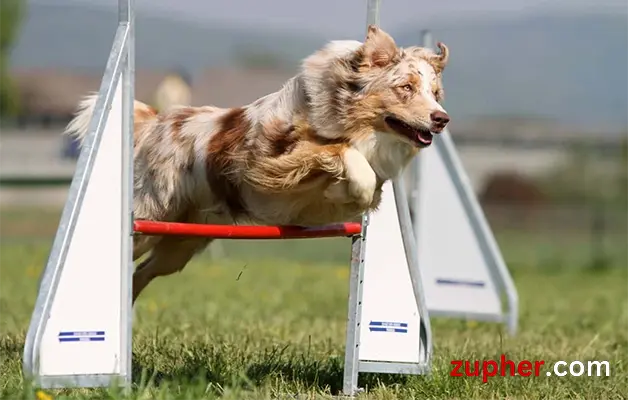What Are the Top Dog Sports for Agility Training?

Introduction
Dog sports involve various activities where dogs and their owners work together to compete or simply have fun. Agility training is a crucial aspect of these sports, focusing on a dog’s physical abilities and mental sharpness. This article aims to delve into the top dog sports suitable for agility training, explaining their significance and how they benefit our furry companions.
A. Definition of Dog Sports
Dog sports encompass a range of organized activities that involve dogs performing tasks or competing alongside their human partners. These activities often highlight the unique skills and abilities of different breeds, providing both mental stimulation and physical exercise for the dogs involved.
B. Importance of Agility Training for Dogs
Agility training plays a vital role in enhancing a dog’s physical fitness, coordination, and mental acuity. Through agility exercises, dogs learn to navigate obstacle courses, jump hurdles, weave through poles, and execute other tasks with precision and speed. This not only improves their overall health but also strengthens the bond between the dog and its owner.
C. Purpose of the Article: Exploring Top Dog Sports for Agility Training
This article aims to explore the most popular dog sports that emphasize agility training. By understanding the various options available, dog owners can choose activities that best suit their pet’s abilities and interests. Whether it’s navigating an agility course, participating in flyball, or engaging in dock diving, there are numerous opportunities for dogs to enjoy and excel in agility-focused sports.

Understanding Dog Agility
Agility training for dogs involves teaching them to navigate obstacle courses with speed and accuracy. It’s like a fun game where dogs learn to jump over hurdles, weave through poles, and balance on platforms. This section will explain the ins and outs of agility training and why it’s beneficial for dogs and their owners.
A. Explanation of Agility Training for Dogs
Agility training is like a workout session for dogs. They learn to follow commands and move through obstacles, improving their physical strength and coordination. It’s a bit like a doggy obstacle course race, where they have to use their brains and bodies to complete challenges.
B. Key Components of Agility Training
- Physical Fitness: Just like humans need exercise to stay healthy, dogs do too! Agility training helps dogs build strong muscles, increase flexibility, and improve cardiovascular health. It’s like going to the gym for dogs, but way more fun!
- Mental Stimulation: Agility courses aren’t just about running and jumping; they also require dogs to think and problem-solve. Figuring out how to navigate obstacles keeps their minds sharp and engaged, preventing boredom and promoting mental well-being.
- Bonding Between Dog and Owner: Agility training is a team effort between dogs and their owners. Working together to overcome obstacles strengthens the bond between them, fostering trust, communication, and mutual respect. It’s like teamwork in action, where both dog and owner cheer each other on to victory.

Overview of Top Dog Sports for Agility Training
In this section, we’ll explore some of the most popular dog sports that focus on agility training. From agility trials to flyball, canine disc, and dock diving, each activity offers unique challenges and benefits for both dogs and their owners.
A. Agility Trials
- Description of Agility Trials: Agility trials are like obstacle courses for dogs, where they race against the clock to navigate through various challenges like jumps, tunnels, and weave poles.
- Types of Agility Trials: Different organizations host agility trials, such as AKC (American Kennel Club), USDAA (United States Dog Agility Association), and UKI (UK Agility International), Each has its own set of rules and competitions.
- Rules and Regulations: Agility trials have strict rules to ensure fair competition and safety for both dogs and handlers. These rules dictate how courses are set up, scoring systems, and eligibility criteria for participating dogs.
B. Flyball
- Introduction to Flyball: Flyball is a relay race where dogs race over hurdles, trigger a ball dispenser, catch a tennis ball, and then race back to their handlers. It’s a fast-paced and exciting sport that requires speed, agility, and teamwork.
- How Flyball Promotes Agility: Flyball challenges dogs to sprint, jump, and use their reflexes, enhancing their agility and coordination. It’s like a high-speed game of fetch that also builds confidence and focus.
- Equipment and Rules: Flyball equipment includes hurdles, a ball dispenser, and a spring-loaded box. Dogs must follow specific rules regarding timing, ball retrieval, and course completion to succeed in flyball competitions.
C. Canine Disc (Frisbee)
- Explanation of Canine Disc: Canine disc, also known as Frisbee, involves dogs catching flying discs thrown by their handlers. It’s a thrilling sport that showcases the bond between dogs and their owners.
- Benefits for Agility Training: Canine disc improves a dog’s agility, endurance, and jumping ability. It requires precise coordination and timing, making it an excellent workout for both body and mind.
- Techniques and Competitions: Dogs learn various catching techniques, such as leaping catches and mid-air grabs. Competitors judge dogs based on their skills, style, and teamwork with their handlers.
D. Dock Diving
- Overview of Dock Diving: Dock diving involves dogs jumping from a dock into a pool of water, aiming for distance or height. It’s a thrilling water sport that showcases a dog’s athleticism and fearlessness.
- Impact on Dog Agility: Dock diving enhances a dog’s agility, strength, and confidence. The act of jumping off the dock requires precise timing and coordination, similar to navigating agility courses.
- Safety Considerations and Competitions: Safety measures such as proper training and supervision are essential in dock diving to prevent injuries. Competitions evaluate dogs based on their jumping performance, with categories for distance, height, and speed.

Comparing the Benefits and Challenges
In this section, we’ll compare the advantages and drawbacks of different dog sports for agility training, considering both physical and mental aspects, as well as practical considerations like breed suitability and cost.
A. Physical Benefits of Each Sport
Each dog sport offers unique physical benefits. Agility trials improve a dog’s speed, strength, and agility, while flyball enhances cardiovascular fitness and reflexes. The canine disc strengthens muscles through jumping and catching, and dock diving promotes endurance and coordination, especially in water.
B. Mental Stimulation Provided by Different Activities
Engaging in various dog sports provides mental stimulation that keeps dogs sharp and focused. Agility trials require quick thinking to navigate obstacles, while flyball demands concentration to retrieve balls. Canine disc challenges dogs to anticipate and catch flying discs, and dock diving tests their bravery and problem-solving skills.
C. Considerations for Different Dog Breeds and Sizes
Certain dog breeds excel in specific sports due to their natural abilities. For example, Border Collies are often top performers in agility trials due to their intelligence and athleticism, while retrievers thrive in flyball with their retrieving instincts. It’s essential to consider a dog’s breed and size when choosing a suitable sport to ensure they enjoy and excel in it.
D. Time and Financial Commitments for Participation
Participating in dog sports requires both time and money. Training sessions, travel to competitions, and equipment expenses can add up. Additionally, some sports may demand more intensive training and practice than others, impacting the time commitment required from both the dog and the owner. It’s essential to consider these factors before committing to a particular sport.

Factors to Consider When Choosing a Dog Sport
When deciding which dog sport is best for your furry friend, several important factors should be taken into account. Understanding your dog’s temperament, your preferences and abilities, access to training facilities and equipment, and long-term goals for your dog’s agility training will help you make the right choice.
A. Dog’s Temperament and Personality
Every dog has a unique temperament and personality that can influence their suitability for different sports. Some dogs may thrive in high-energy activities like agility trials, while others may prefer more laid-back sports like a canine disc or dock diving. It’s essential to consider your dog’s temperament and interests when selecting a sport to ensure they enjoy and excel in it.
B. Owner’s Preferences and Abilities
As a dog owner, your preferences and abilities play a significant role in choosing a dog sport. Consider your own interests, physical fitness, and availability for training and competitions. It’s essential to select a sport that you enjoy and feel comfortable participating in alongside your dog.
C. Access to Training Facilities and Equipment
Access to training facilities and equipment is another crucial factor to consider. Some sports, like agility trials, may require specialized equipment and dedicated training spaces, while others, like canine disc, can be practiced in parks or open areas. Ensure you have access to the necessary resources for your chosen sport to facilitate effective training and skill development.
D. Long-term Goals for the Dog’s Agility Training
Consider your long-term goals for your dog’s agility training when choosing a sport. Whether you aim to compete at a high level, participate in recreational activities, or simply provide your dog with mental and physical stimulation, selecting the right sport aligns with your aspirations. Discuss your goals with trainers or experienced handlers to determine the most suitable path for your dog’s agility journey.
Tips for Getting Started in Dog Sports
Embarking on your dog’s agility training journey can be exciting, but it’s essential to start off on the right paw. Here are some helpful tips to guide you through the process of getting started in dog sports.
A. Finding Local Clubs or Organizations
Begin by searching for local clubs or organizations that offer dog sports activities in your area. These groups often provide training classes, practice sessions, and opportunities to participate in competitions. Joining a club can connect you with like-minded individuals and resources to support your dog’s agility training journey.
B. Seeking Guidance from Experienced Trainers
Seek guidance from experienced trainers who specialize in the specific dog sport you’re interested in. These trainers offer valuable insights, techniques, and personalized guidance to enhance you and your dog’s performance. Learning from experienced professionals ensures that you receive proper guidance and support throughout the training process.
C. Gradual Introduction to Different Sports
Introduce your dog to different sports gradually to discover their interests and strengths. Start with basic training exercises and gradually incorporate elements of agility, flyball, canine disc, or dock diving. Observing your dog’s reactions and abilities will help you determine which sports they enjoy and excel in.
D. Importance of Patience and Consistency in Training
Patience and consistency are key to successful dog sports training. Rome wasn’t built in a day, and neither are champion agility dogs. Be patient with your dog as they learn new skills, and remain consistent with training sessions and routines. Positive reinforcement and praise will motivate your dog to continue progressing in their agility training journey.
Conclusion
As we wrap up our exploration of dog sports for agility training, let’s recap the key points and encourage dog owners to embark on this exciting journey with their furry companions.
A. Recap of the Top Dog Sports for Agility Training
We’ve covered a range of exciting dog sports, including agility trials, flyball, canine disc, and dock diving, each offering unique challenges and benefits for dogs and their owners.
B. Emphasis on the Benefits of Participating in Dog Sports
Participating in dog sports provides numerous benefits, including physical exercise, mental stimulation, and the opportunity to strengthen the bond between dogs and their owners. These activities promote overall well-being and enhance the quality of life for both dogs and humans.
C. Encouragement for Dog Owners to Explore Agility Training Opportunities
We encourage dog owners to explore agility training opportunities available in their communities. Whether you’re experienced or just starting, there’s something in dog sports for everyone to enjoy.
D. Closing Thoughts on the Bond Between Dog and Owner Fostered Through Sports
Dog sports foster a special bond between dogs and their owners, built on trust, teamwork, and shared experiences. Through training, competing, and celebrating achievements together, this bond grows stronger, enriching both the lives of dogs and their devoted companions.
People also ask
What is the most popular dog sport?
The most popular dog sport is agility trials, where dogs navigate obstacle courses.
What dogs are good for agility training?
Breeds like Border Collies, Australian Shepherds, and Shetland Sheepdogs excel in agility training.
What is the most common agility dog?
The Border Collie is considered the most common breed for agility training.
What type of sports can dogs do?
Dogs can participate in a variety of sports, including agility, flyball, disc, and dock diving.
What is the most difficult dog sport?
Some consider agility trials to be the most challenging dog sport due to the precision and speed required.
What is the easiest dog sport?
Canine disc (Frisbee) is often considered one of the easier dog sports to get started in.



